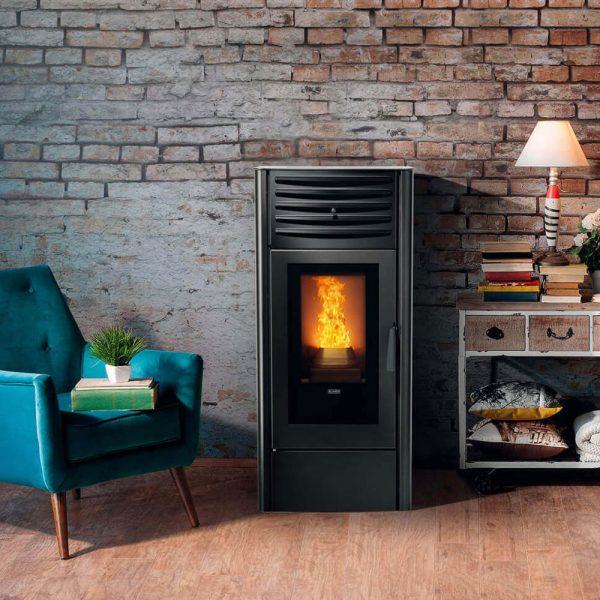A pellet heater is a modern, highly efficient home heating appliance that burns compressed wood pellets to create a comfortable, natural heat. Combining the convenience of a heat pump with the real warmth of a wood fire, pellet heaters offer an automated, eco-friendly, and cost-effective heating solution that’s perfect for Australian homes. If you’ve never heard of pellet heaters before, don’t worry – you’re not alone. Most people know very little about them, but once you understand how pellet heaters work and their benefits, you’ll see why they’re becoming increasingly popular as an alternative to traditional wood heaters and heat pumps.

In This Guide, You’ll Learn:
- How They Work: An automated system that feeds wood pellets into a burn pot for hassle-free heating
- Key Benefits: Pellet heaters provide real, natural heat with the convenience of push-button operation
- Efficiency & Cost: They are over 90% efficient and can be more affordable to run than electric heaters
- Environmental Impact: They are an eco-friendly option, often using recycled wood waste
How Do Pellet Heaters Work?
Understanding how pellet heaters work is pretty straightforward. Think of them as an automated wood fire that runs itself. Here’s the basic process:
- The Hopper: This container holds your wood pellets (usually a day’s worth or more)
- The Auger: An automated screw system that feeds pellets from the hopper into the burn pot
- The Burn Pot: Where the pellets are burned to create heat
- The Fans: Circulate the hot air throughout your room, just like a heat pump
When you switch on a pellet heater, pellets are automatically fed into the burn pot, and within a few minutes, a fire starts and begins heating your room. There’s no need to manually light anything – it’s completely automatic. Read more about pellet heaters vs wood heaters vs heat pumps if you are interested in what is similar and different between these heaters and which one might be best for you.
For a more detailed explanation with diagrams and technical specifications, see our full guide on how pellet heaters work.
Are Pellet Heaters Eco-Friendly?
One of the biggest advantages of pellet heaters is how environmentally friendly they are. Wood pellets are carbon neutral and a much cleaner way to heat your home. Here’s why they’re better for the environment than traditional heating methods, such as a wood heater:
Waste Wood Recycling: Pellet heaters burn small, cylindrical wood pellets made from waste wood material like sawdust that was previously thrown away. This waste material is now recycled and used for heating instead of ending up in landfills.
Sustainable vs. Old Growth: Compare this with traditional wood heaters where old forest growth is cut down and will never grow back. Pellet heaters can burn both softwood and hardwood pellets, so some pellet mills plant fast-growing plantation forests specifically for making wood pellets.
Plantation Timber Benefits: While you might think “that’s still cutting down trees,” plantation timber is grown specifically for heating purposes. This is incredibly eco-friendly because:
- Plantation timber grows fast
- It’s perfect for making pellets since pellet heaters burn both softwood and hardwood efficiently
- Wood heater owners typically avoid plantation timber because it doesn’t burn well in traditional wood heaters
I also wrote an article on the history of wood pellets because their original origins are very interesting.
Pros and Cons of Pellet Heaters
Before making any heating decision, it’s important to understand both the advantages and disadvantages. Here’s an honest breakdown of pellet heaters to help you decide if they are right for you:
Pros:
- Real Heat: Creates the same cozy, natural warmth as a wood fire
- Automated Operation: No manual lighting or constant attention required
- Highly Efficient: About 90% efficiency means lower running costs
- Eco-Friendly: Burns recycled waste wood materials
- Quick Heating: Convection heating warms rooms within minutes
- Low Maintenance: Only need to refill hopper once daily during peak winter
Cons:
- Requires Electricity: Won’t work during power outages
- Regular Cleaning: Needs periodic maintenance and ash removal
- Pellet Availability: You need to ensure consistent pellet supply
- Initial Cost: Higher upfront investment than some alternatives
For a comprehensive analysis of potential drawbacks, learn more about the disadvantages of a pellet heater before you buy.
Types of Pellet Heaters
There are two main types of pellet heaters to consider:
Freestanding Pellet Heaters: These are standalone units that can be placed anywhere in your room with proper ventilation. They’re perfect if you want flexibility in placement and typically offer more heating capacity.
Insert Pellet Heaters: These are designed to fit into existing fireplaces, making them ideal if you want to convert an old wood fireplace into a modern, efficient heating system.
Unsure which type is right for your home? Read our detailed comparison of freestanding vs. insert pellet heaters to help make your decision.
The 3 Core Benefits of a Pellet Heater
Understanding the key advantages of pellet heaters will help you see why they’re becoming such a popular heating choice. Here are the three main benefits that set them apart:
1. Automated Convenience
One of the most appealing aspects of pellet heaters is how easy they are to use. When you switch on a pellet heater, it does everything automatically – pellets are fed into the burn pot, the fire starts, and your room begins warming up without any manual intervention.
Fully Automatic Operation: There’s no need to manually light fires or constantly tend to them like traditional wood heaters. You’ll only need to refill the hopper once every day or two at most during peak winter, and when you’re finished, simply push a button and the heater will shutdown within a few minutes and the fire will go out.
Simple Use: Compare this to traditional wood heaters where you have to manually light fires and continuously add firewood throughout the day and night. With pellet heaters, check the hopper once every day or two, tip in a bag of pellets when needed, and you’re done.
2. Fast, Effective Heat
The heat created by pellet heaters is transferred into your room via fans, similar to how heat pumps work. This makes them convection heaters, which means they’re incredibly quick at heating rooms.
Quick Heat Distribution: Hot air is blown directly into your room, so within minutes warm air begins circulating and warming up your space. Traditional wood heaters are primarily radiant heaters and can take an hour or more before a room has properly warmed up.
Size Options: Pellet heaters come in different sizes ranging from small units around 6kW to large units about 13kW, making them suitable for almost all house sizes.
3. Eco-Friendly Fuel
Pellet heaters burn small, cylindrical wood pellets made from waste wood material like sawdust that was previously thrown away. This waste material is now recycled and used for heating instead of ending up in landfills.
Sustainable vs. Old Growth: Compare this with traditional wood heaters where old forest growth is cut down and will never grow back. Pellet heaters can burn both softwood and hardwood pellets, so some pellet mills plant fast-growing plantation forests specifically for making wood pellets.
What Kind of Fuel Do Pellet Heaters Use?
The fuel that powers your pellet heater is just as important as the heater itself. Wood pellets are small, cylindrical pieces of compressed sawdust and wood waste that burn very efficiently.
What Makes Good Pellets: Quality pellets are made from clean wood waste without additives or chemicals. They should be uniform in size and have low moisture content for optimal burning.
Pellet Types: You can choose from hardwood pellets, softwood pellets, or a mixture of both. Each type has different burning characteristics and costs.
The quality of your fuel directly affects your heater’s performance and efficiency. Learn more in our comprehensive guide to hardwood vs. softwood pellets to choose the right fuel for your needs.
Are Pellet Heaters Right for You?
I think pellet heaters are the best option for anyone wanting real heat without the mess and hassle of traditional wood heating. They’re perfect if you:
- Want the warmth and ambiance of a real fire without the work
- Value convenience and automation in your heating
- Are environmentally conscious and want sustainable heating
- Need quick, efficient room heating
- Don’t want to deal with chopping, storing, and constantly feeding wood
Just imagine walking into a freezing room, hitting the button on your pellet heater, and within a few minutes having a warm, toasty space. That’s the convenience and comfort pellet heaters offer. If this sounds like your kind of heating then check out my where to buy a pellet heater in Tasmania and buying a pellet heater in Australia for a list of pellet heater retailers.
Getting Started with Pellet Heaters
If you’re totally new to pellet heaters, I strongly recommend checking out our pellet heater reviews to see which models might work best for your situation. These reviews will help introduce you to the wonderful world of pellet heaters and give you a better idea of what’s available. I’ve also got detailed information on how much it costs to run a pellet heater so you can get an idea of what you’d spend to heat your house during winter.
For more detailed information about specific aspects of pellet heater ownership, check out our pellet heater FAQ page where we answer the most common questions from new pellet heater owners.
Summary
I think pellet heaters are the best option for anyone wanting real heat with no mess. They’re eco-friendly because pellets are made from waste wood material like sawdust, instead of cutting down trees. Pellet heaters are super easy to use and switch on automatically, no need to fuss with matches or lighters. They’re like a heat pump, which means they heat up a room real fast. Just imagine you’ve just walked into a freezing room, hit the button on your pellet heater, and boom! Within a few minutes, the room is all warm and toasty.
And the best part? You don’t have to keep putting more pellets in all day like you have to with a wood heater. One bag of pellets should last a whole day. So, if you want an easy, eco-friendly way to heat up your home, you should definitely check out pellet heaters. If you are totally new to pellet heaters then I strongly recommend checking out the top 5 pellet heaters in Tasmania article if you live in Tassie or the best pellet heater in Australia. They are basically pellet heater reviews and will help introduce you to the wonderful world of pellet heaters.
Now that you know the basics of what a pellet heater is, find out if one is right for you in our complete pellet heater beginner’s guide.
Resources
Wikipedia on Pellet Heaters
